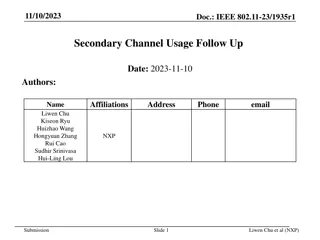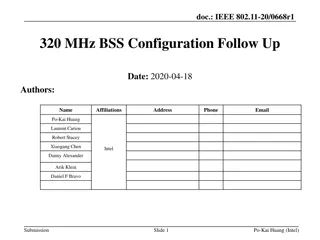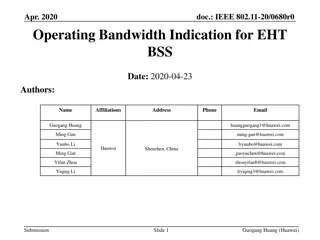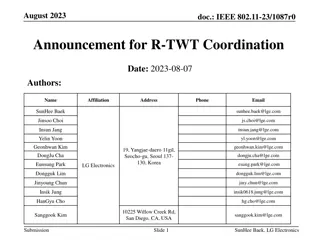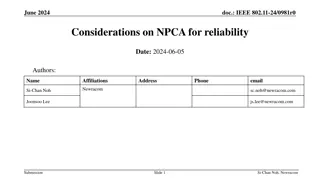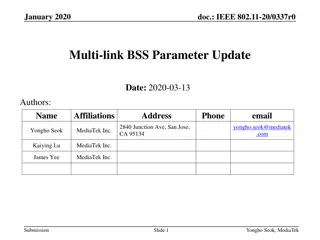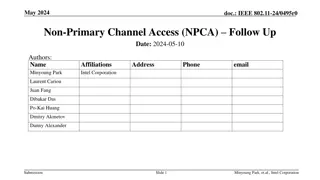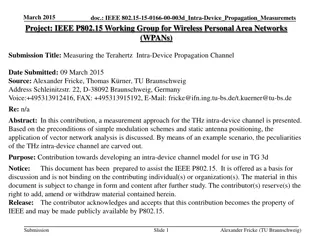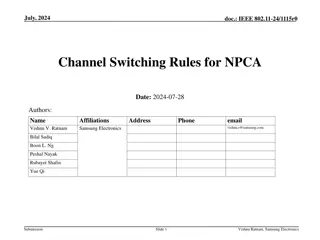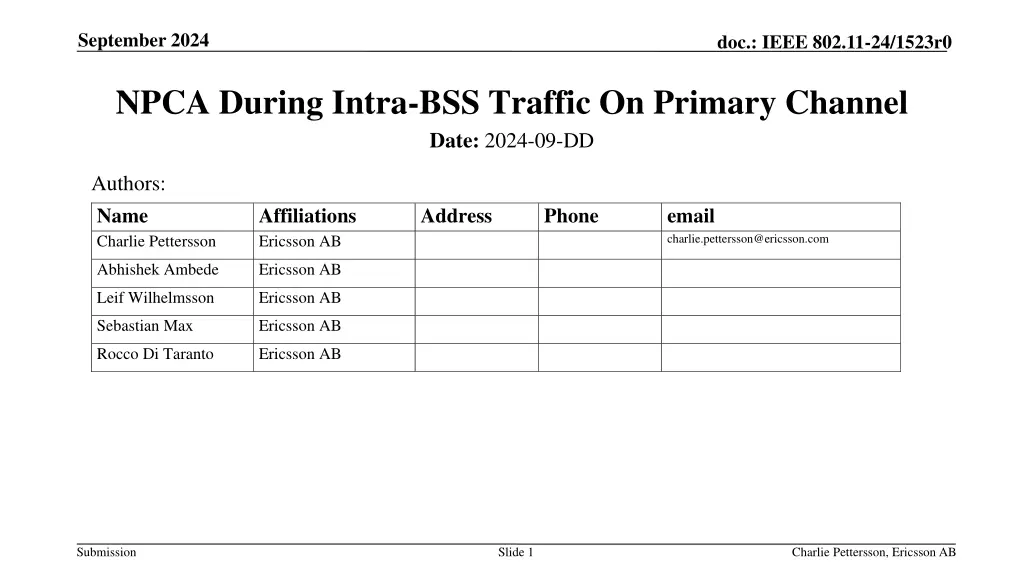
Understanding Wi-Fi Spectrum Efficiency Enhancement through NPCA Mode
Explore the concept of Non-Primary Channel Access (NPCA) mode in Wi-Fi networks, allowing devices to utilize secondary channels efficiently in the presence of spectrum mismatches. Learn about the challenges and opportunities for enhancing spectrum efficiency in intra-BSS traffic scenarios.
Download Presentation

Please find below an Image/Link to download the presentation.
The content on the website is provided AS IS for your information and personal use only. It may not be sold, licensed, or shared on other websites without obtaining consent from the author. If you encounter any issues during the download, it is possible that the publisher has removed the file from their server.
You are allowed to download the files provided on this website for personal or commercial use, subject to the condition that they are used lawfully. All files are the property of their respective owners.
The content on the website is provided AS IS for your information and personal use only. It may not be sold, licensed, or shared on other websites without obtaining consent from the author.
E N D
Presentation Transcript
September 2024 doc.: IEEE 802.11-24/1523r0 NPCA During Intra-BSS Traffic On Primary Channel Date: 2024-09-DD Authors: Name Charlie Pettersson Affiliations Ericsson AB Address Phone email charlie.pettersson@ericsson.com Abhishek Ambede Ericsson AB Leif Wilhelmsson Ericsson AB Sebastian Max Ericsson AB Rocco Di Taranto Ericsson AB Submission Slide 1 Charlie Pettersson, Ericsson AB
September 2024 doc.: IEEE 802.11-24/1523r0 Abstract TGbn has agreed to define a non-primary channel access (NPCA) mode which allows a STA to opportunistically access a non-primary channel in a BSS when the primary channel of that BSS is occupied by an OBSS. NPCA related motioned text from SFD [1]: TGbn defines a mode of operation that enables a STA to access the secondary channel while the primary channel is known to be busy due to OBSS traffic or other TBD conditions. The mode of operation shall not assume that the STA is capable to detect or decode a frame and obtain NAV information of the secondary channel concurrently with the primary channel. A BSS shall only have a single NPCA primary channel (name TBD) on which the STA contends while the primary channel of the BSS is known to be busy due to OBSS traffic or other TBD conditions. In this contribution, we discuss an opportunity to support NPCA during intra-BSS traffic on the primary channel. Submission Slide 2 Charlie Pettersson, Ericsson AB
September 2024 doc.: IEEE 802.11-24/1523r0 Background There can be a large mismatch in operating bandwidths of AP and non-AP STAs in Wi-Fi networks. In recent Wi-Fi generations, AP STAs are mandated to support wide operating bandwidths such as 80 MHz (applicable for Wi-Fi 7 in 5 GHz, Wi-Fi 6 (6E) in 5(6) GHz) or 160 MHz (applicable for Wi- Fi 7 in 6 GHz) [2, 3]. Moreover, Wi-Fi 7 AP STAs may support operating bandwidths up to 320 MHz, and Wi-Fi 6/6E AP STAs may support operating bandwidths up to 160 MHz. Non-AP STAs have no such mandatory bandwidth requirements and may support an operating bandwidth as low as 20 MHz only. Some standardized (e.g, SST in 802.11ah and OFDMA in 802.11ax) or discussed (e.g., DSO in TGbn) modes of operation may help to address the abovementioned bandwidth mismatch, however an AP STA is required to be in control in all these modes. Meanwhile, EDCA is understood to be the main channel access mechanism in real-world Wi-Fi deployments [4] it provides differentiated, distributed channel access to both APs and non-APs. Submission Slide 3 Charlie Pettersson, Ericsson AB
September 2024 doc.: IEEE 802.11-24/1523r0 Problem BSS When devices with mismatched operating bandwidths are communicating in a BSS, large portions of the spectrum may be wasted in the BSS, e.g., when TXOPs are initiated by narrow bandwidth non-AP STAs. Example: If a 20 MHz non-AP STA wins contention and initiates a TXOP with a 160 MHz AP STA, 140 MHz bandwidth will be wasted. STA1 160 MHz STA3 80 MHz AP 160 MHz STA2 20 MHz STA4 40 MHz Frequency 80 MHz wasted in the BSS 160 MHz BSS Secondary 80 MHz 160 MHz intra-BSS TXOP 1 140 MHz wasted in the BSS Secondary 40 MHz 80 MHz intra-BSS TXOP 3 Secondary 20 MHz Time 20 MHz intra-BSS TXOP 2 Primary 20 MHz Submission Slide 4 Charlie Pettersson, Ericsson AB
September 2024 doc.: IEEE 802.11-24/1523r0 Opportunity When the full operating bandwidth of a BSS is not utilized in a TXOP, idle portions of the remaining bandwidth could be used for opportunistic communications in the same BSS. Such opportunistic NPCA operation during intra-BSS traffic on the primary channel could provide multiple advantages: Improved overall throughput, Improved spectrum usage in the BSS, Transparent operation for legacy devices communicating on primary channel, Improved support for low latency applications, for example, by enabling transmission of high priority packets or buffer status reports on a non-primary channel. Most of the considerations and concepts being discussed in TGbn for OBSS traffic based NPCA could be reused for intra-BSS traffic based NPCA without large efforts. Submission Slide 5 Charlie Pettersson, Ericsson AB
September 2024 doc.: IEEE 802.11-24/1523r0 Example Illustration and Some Potential Challenges Frequency 40 MHz opportunistic intra- BSS TXOP using NPCA 40 MHz opportunistic intra-BSS TXOP using NPCA 160 MHz BSS Secondary 80 MHz 160 MHz intra-BSS TXOP 1 40 MHz wasted in the BSS 100 MHz wasted in the BSS Secondary 40 MHz 80 MHz intra-BSS TXOP 3 Secondary 20 MHz Time 20 MHz intra-BSS TXOP 2 Primary 20 MHz The following are some potential challenges that may need to be addressed: Ensuring acceptable probability of successful packet reception in both TXOPs, i.e., the baseline TXOP occupying the primary channel, and the opportunistic TXOP obtained using NPCA. Ensuring fairness to legacy devices operating in the BSS when proposed type of NPCA is supported. Submission Slide 6 Charlie Pettersson, Ericsson AB
September 2024 doc.: IEEE 802.11-24/1523r0 References 1) 11-24/209r4, Specification Framework for TGbn. 2) IEEE Std 802.11ax, 2021. 3) Draft P802.11be D7.0, 2024. 4) 11-24/0840r0, Low latency channel access, Dmitry Akhmetov et. al. Submission Slide 7 Charlie Pettersson, Ericsson AB
September 2024 doc.: IEEE 802.11-24/1523r0 Straw Poll Do you believe TGbn should consider NPCA also when primary channel is known to be busy due to intra-BSS traffic? Yes No Submission Slide 8 Charlie Pettersson, Ericsson AB

